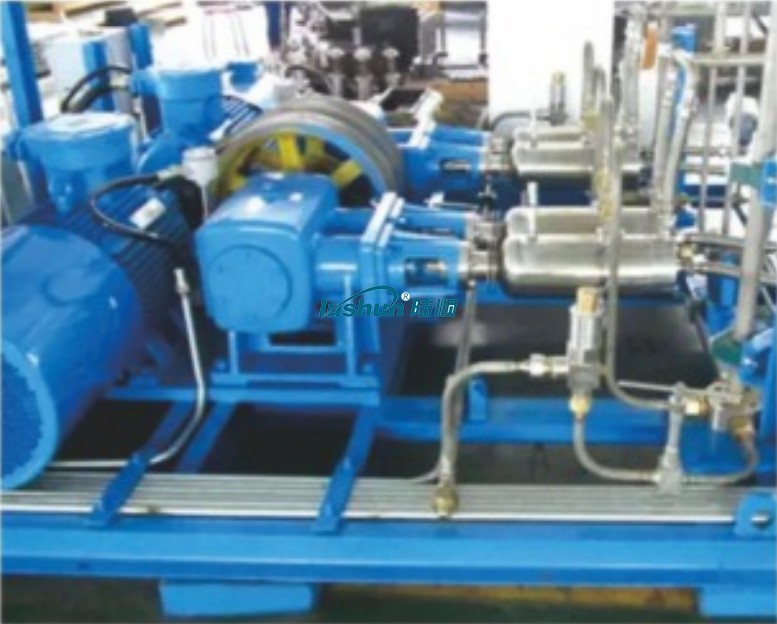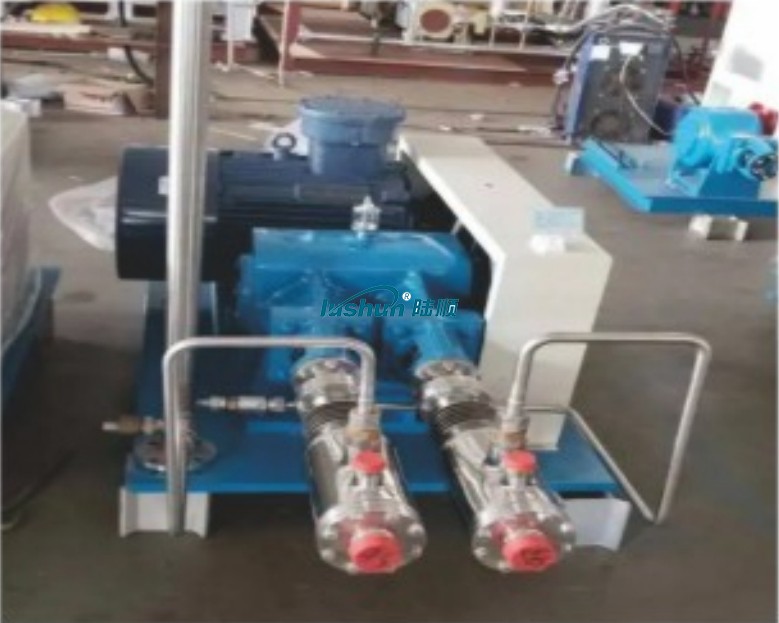LNG Low Temperature High Pressure Plunger Pump
LNG low-temperature and high-pressure plunger pump is suitable for low-temperature liquid pressurization systems. It has stable performance, easy operation, and convenient maintenance. Under good installation conditions, the pump start-up time is less than 10 minutes. The pump head can be independently removed and reinstalled after maintenance. This process can be completed within 2-4 hours. The flow-through design allows the pump to restart without the need for pressure relief.
The function of the pump drive end is to convert the rotational motion of the motor into reciprocating motion, and transmit the output power of the motor to the compression end of the pump head. The motor successfully converts through components such as pulleys, eccentric wheels, connecting rods, and cross heads. The camshaft and bearing structure of the transmission system are immersed in oil, which greatly extends the lifespan of the power system. The lubricating oil inside the gearbox is N46 # mechanical oil, which has been adjusted before leaving the factory.
The hydraulic end of the pump head is composed of cylinder liner, cylinder body, piston assembly, seal, inlet valve, discharge valve, etc. This pump uses PTFE filled piston rings with good wear resistance, resulting in a long working life. The seal is composed of a combination of sealing components with various sealing properties, ensuring the reliable and fault free operation of the pump under normal working pressure.


VRP Series Varnish Removal Oil Purifier
Application
Used in gas and steam turbine, compressor, to remove dissolved and suspended soft pollutants in oil products, sludge and other harmful substances. Avoid turbine failures and expensive oil changes due to paint film problems. When the film is formed, the loss of production is very high. The initial formation of the film is known as a soft pollutant, caused by hot spots in the system, such as bearings, pumps, and high flow on-line filtration. Recent studies have found that the existence of soft pollutants can be divided into dissolved state and suspended state, by removing these soft oxides can avoid the production of paint film. Once the film forms, it will clog valves, filters and other small links, and the life of the oil will be significantly reduced.
The formation of cleaning film will cause the following adverse consequences: valve adhesion, loss of control, resulting in unit failure or startup failure; Filter plugging, limiting oil flow, resulting in oil temperature rise and wear increase; Heat exchange failure, oil temperature rise; Sandpaper surface, increase component wear; Forming paint on the bearing, limiting flow, increasing wear and temperature; Frequent oil changes and system flushes. When the soft pollutants are dissolved in the oil, typically when the oil temperature is above 40℃, they cannot be removed by ordinary mechanical filtration or electrostatic filtration, and these soft pollutants show natural magnetism. For polar absorption, the cooler metal surface "cold spot", i.e. the valve and cooler. When the temperature of the oil is lowered, the thermal stability of the soft pollutants is less than that of the oil, so they are more likely to bake hard on hot surfaces, such as axial shafts.
VRP paint film cleaner. It achieves revolutionary and efficient removal of soft pollutants (dissolved and suspended) from oil products, including gas and steam turbines and compressors under high temperature operation. The warm oil is pumped from the lowest point at the bottom of the tank to the VRP paint film purifier by the equipment's own transfer pump. After cooling treatment (using the thermal stability of the paint film is worse than that of oil), the paint film, particulate matter and moisture are removed by the filter element with wood fiber as the raw material (no need to use ion-exchange resin filter material, greatly saving the cost of use).
Features:
● Increase system reliability and stability. ● No more shutdowns and startup failures caused by paint film.
● No longer need to clean the tank and system flushing. ● Increase jacking oil pressure, more stable bearing temperature.
● Improve the life of oil products, blood additives and system components, such as bearings, valves, seals, etc.
● Great savings can be achieved by avoiding turbine failure and extending the life of oil products. Features:
● Increase system reliability and stability. ● No more shutdowns and startup failures caused by paint film.
● No longer need to clean the tank and system flushing. ● Increase jacking oil pressure, more stable bearing temperature.
● Improve the life of oil products, blood additives and system components, such as bearings, valves, seals, etc.
● Great savings can be achieved by avoiding turbine failure and extending the life of oil products.
Technical Specification
|
Model |
VRP-10 |
|
Flow |
10L/min |
|
Working Pressure |
≤0.5Mpa |
|
Total Power |
5.55KW |
|
Power Supply |
AC380V/50Hz |
|
Overall Dimension |
1466mm×1126mm×1750mm |
|
Net Weight |
500kg |
|
Particle contamination degree(NAS1638)
|
≤6grade |
|
MPC data |
<15 |
■Above size and weight of this equipment are for reference only, the specific data shall be subject to its physical object.

why removing oil varnish?
The causes of varnish in industrial oil systems. We looked at how oil degradation produces submicron that eventually cluster and stick to metal surfaces, turning into varnish. Left unchecked, varnish can lead to varying levels of equipment failure, costly downtime, expensive repairs or, in the worst cases, complete replacement.
When the lubricant inevitably oxidizes and varnish precursors are formed, varnish removal systems are necessary to prevent degradation products from accumulating to the point where varnishing occurs.
Why be concerned about varnish?
Varnish contamination has become a significant maintenance problem in many critical hydraulic and lubrication oil applications, such as gas turbines, compressors, and hydraulic presses. Varnish contamination in Gas Turbine Lube Oil Systems has been a particularly high profile issue over the last decade. A very small amount of varnish that plates out on the metal surfaces within the lube oil system (such as a servo-valve) can cause inefficient operation or prevent the system from starting properly, resulting in a fail-to-start condition or in some cases a unit trip.
how can it be prevented or eliminated?
Our Varnish Removal Systems (VRP) were developed to address the need to properly remove varnish (also known as lacquer, sludge, or tar) commonly found in various lubrication and hydraulic systems. Our process utilizes either granular adsorbent media or depth media filter elements to effectively remove dissolved and suspended oil degradation products (i.e. the cause of varnish). Varnish removal is accomplished with oxidatively stable media, engineered to selectively remove only the varnish-causing contaminants without disturbing the oil's additive package.





Home / Products / About Us / Application / Services / News / Contact Us